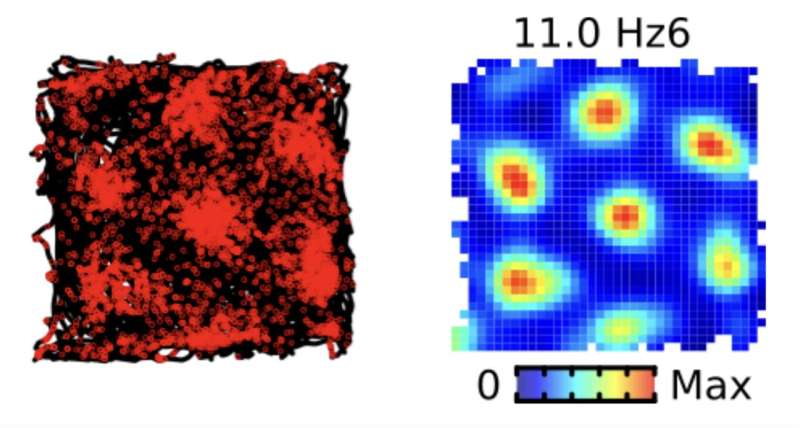Grid cells are a class of specialized neurons in a brain region called the entorhinal cortex, which is known to support spatial navigation and some memory processes. Past neuroscience studies have found that as humans and other animals move in their surroundings, these cells fire following a grid-like pattern, creating a sort of internal map of the environment.
Researchers at the Medical Faculty of Heidelberg University, the German Cancer Research Center and EBRI recently carried out a study aimed at shedding new light on the processes via which grid cells encode an animal’s position in space and contribute to spatial navigation. Their findings, published in Nature Neuroscience, suggest that rather than creating and retaining a single global map, these cells produce multiple local maps that can guide the future behavior of animals in their surrounding space.
“Soon after the discovery of grid cells by the group of May-Britt and Edvard Moser, it was proposed that these neurons might support path integration,” Kevin Allen, senior author of the paper, told Medical Xpress. “In this fundamental navigation process, an animal estimates its position by continuously integrating self-motion cues, even in the absence of external landmarks. However, most previous studies of grid cells were conducted in environments rich in external cues, making it difficult to isolate the path-integration processes.”
To overcome the limitations of previous related studies, Allen and his colleagues developed a new experimental paradigm that would allow them to record the activity of grid cells while animals estimated their position solely by integrating self-motion cues. The key objective of their recent study was to better understand how grid-cell representations are maintained or reorganized over time, particularly when external reference points (i.e., landmarks that animals encountered before) are removed.

“The method we use to decode movement from the activity of grid cells is rather complex,” explained Allen. “We first needed to improve our recording technique so that we could record more than ~10 grid cells simultaneously in freely moving mice. The key advancement was the use of high-density silicon probes, which allowed us to capture the coordinated activity of many grid cells with high precision.”
After they identified a reliable method to simultaneously record the activity of many grid cells, the researchers developed an algorithm that can estimate an animal’s movements based on this recorded activity. This technique relies on a known fact, namely that the relative positions of grid-cell firing fields are fixed with respect to one another.
“For example, if grid cell A always fires 20 cm north of where grid cell B fires, then observing that cell B is active just before cell A suggests the animal has moved 20 cm north,” said Allen. “We trained an artificial neural network to learn these relationships automatically and to predict the movement of the mice from the sequential firing patterns of groups of grid cells. This approach enabled us to directly read out the animal’s movement from neural activity.”
Using their newly developed algorithm, Allen and his colleagues were able to gather interesting new insights about how grid cells represent an animal’s surroundings. Their findings suggest that instead of representing a single, fixed global coordinate system, the cells rely on a spatial reference frame that can shift dynamically in response to recent experiences and context.
“To illustrate this idea, imagine entering a room in complete darkness: at first, your internal sense of position might be anchored to the doorway where you entered,” said Allen. “Yet after bumping into a sofa, your internal ‘map’ might shift, becoming anchored to this new reference point. Similarly, in our experiments, the anchoring point of grid-cell maps changed during navigation, suggesting that the brain’s spatial coordinate system is flexible and context-dependent, rather than fixed to an absolute reference.”
Notably, the results gathered by Allen and his colleagues challenge long-standing assumptions within the neuroscientific community about how grid cells contribute to spatial navigation. In contrast with some earlier works, they suggest that these cells map environments more adaptively than originally anticipated, dynamically updating the location of an animal in space.
Future studies could build on the team’s findings. For instance, trying to further elucidate the processes via which grid cells update local maps in response to external or contextual cues. Concurrently, this work could inform the development of new grid cell-inspired computational systems that could improve the creation of maps and robot navigation.
Written for you by our author Ingrid Fadelli, edited by Gaby Clark, and fact-checked and reviewed by Robert Egan—this article is the result of careful human work. We rely on readers like you to keep independent science journalism alive.
If this reporting matters to you,
please consider a donation (especially monthly).
You’ll get an ad-free account as a thank-you.
More information:
Jing-Jie Peng et al, Grid cells accurately track movement during path integration-based navigation despite switching reference frames, Nature Neuroscience (2025). DOI: 10.1038/s41593-025-02054-6.
© 2025 Science X Network
Citation:
Grid cells create multiple local maps rather than single global system for spatial navigation, study finds (2025, October 20)
retrieved 20 October 2025
from https://medicalxpress.com/news/2025-10-grid-cells-multiple-local-global.html
This document is subject to copyright. Apart from any fair dealing for the purpose of private study or research, no
part may be reproduced without the written permission. The content is provided for information purposes only.

